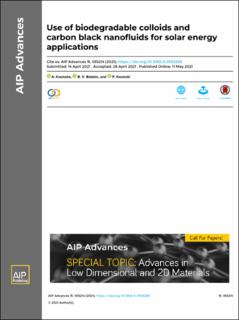| dc.description.abstract | The conversion of solar energy to heat can be performed in direct absorption solar collectors, where the radiation from the sun is absorbed by a fluid. There are various types of fluids that can be used, and recently, nanofluids (i.e., liquids with immersed nanoparticles) have been investigated by researchers. Nevertheless, nanofluids have inherent drawbacks such as cost, toxicity, and clogging. This paper considers the use of fluids that are inexpensive and neutral to the environment, namely, coffee colloids. These types of fluids have already been tested for solar energy applications, but they have not yet been compared with nanofluids. In this research, we conducted a series of simple experiments where both coffee colloids and carbon black nanofluids were analyzed under the same conditions. According to our results, the thermal efficiency of coffee colloid and the nanofluid systems is, respectively, 12% and 16% greater than that of pure water. In addition to the experiments, we developed a mathematical model that is based on the Beer–Lambert law and a heat balance equation. Despite its simplicity, the model predicts the results relatively well. | en_US |

